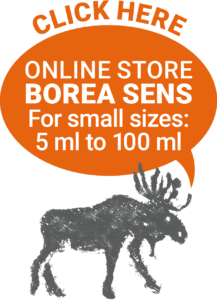Larch Tamarack ESSENTIAL OIL

Latin Name: Larix laricina
French Name: Mélèze Laricin
English Name: Larch Tamarack
Family: Pinaceae
Origin: Quebec, Canada
Harvest time: July to September
Distilled Part: Twigs & Needles
Organoleptic Specificities: Clear and colorless with the smell of fresh conifer; balsamic, exotic and woody
Components: α-pinene, Δ3-carene, β-pinene, bornyl acetate, β-pinene, myrcene, camphene
ORIGIN
The tamarack or American larch is also called a ‘red spruce’ in the vernacular of our French ancestors. Because the different resinous trees were misunderstood, they were all grouped with the same name. Today we know that these trees are part of the Pinaceae family and not the Epiceae family, like black or white spruce. The peculiarity of this native tree is that it is the only Canadian conifer to lose its needles at the end of autumn. But before losing its needles, they will change from green to a flamboyant golden yellow. Thus, adding to the many vibrant autumnal colours of our beautiful Canadian forests.
The larch is found all over Canada. The terrain conducive to its development is moist, light and well-drained soils, but it does not tolerate much shade, which would explain its presence in sphagnum peat bogs. Under ideal conditions, it can reach up to 22 meters in height after twenty years of growth. It grows three times faster than a fir or spruce tree.
Its bark is grey when it is young and turns into small reddish brown scales over time. The larch’s cones are less than 2 cm long and can stick to the tree for a year. During flowering, the flowers of the male cones are yellow and those of the female cones are pink. Its needles are supple and soft to the touch. They are light green and measure 2 to 5 cm in length. They grow back every spring in groups of 30 to 40 per cluster.
Its hard and heavy wood is resistant to moisture and makes it an excellent choice for outdoor use. It is used to make patios, shingles, stilts, boats, and canoe skins, as well as studs, poles and railroad ties. In the past, barn floors were made with this essential wood, because its durability allowed it to resist the hooves and urine of horses!
The larch is the official emblem tree for the Northwest Territories.
HISTORY
Several Amerindian tribes made a decoction of larch needles along with the cambium to help with colds, fever and the flu. Young branches were infused for their laxative power. A poultice made from the inside of the bark plus its leaves, dried up draining wounds and stopped hemorrhaging. This tree possessed many benefits including those of helping in cases of rheumatism, tuberculosis, anemia and even gonorrhea.
KEY BENEFITS
PHYSICAL
- Circulatory system: tonic for the lymphatic system.
- Digestive system: appetite stimulant, digestive, eupeptic affect, stomachic, intestinal
antispasmodic with analgesic action, antifungal, relaxes solar plexus knots.
- Endocrine system: mimetic cortisone (hypophyso-cortico-adrenal axis) with a targeted action on the smooth muscles of organs.
- Immune system: aerial antiseptic, antifungal, antibacterial, antiviral, antiparasitic (larvicidal effect against aedes aegypti).
- Respiratory system: lymphotonic, decongestant (exocrinostimulant of mucin producing glands), anti-inflammatory, Koch mycobacteria (TB).
- Nervous system: relaxing, neurotonic, regulates serotonin (the happiness hormone).
- Osteo-articular system: anti-inflammatory, analgesic, decongestant.
PSYCHIC
Psychically invigorating, increases the ability to concentrate, promotes logical reasoning, mental stimulant, increases psychic resistance.
Uses: Bronchitis ++, pneumonia ++, mycobacterium tuberculosis ++ (Koch TB), fatigue, arthrosis, promotes sleep and calms chronic pain.
Contraindications: None known under normal physiological doses: 1-2 drops per use and 2-3 times per day.
May cause redness with pure dermal application in the long term if the product is oxidized. The presence of ‘alpha-pinene‘ and ‘delta-3-carene‘ can cause skin sensitization if the product is oxidized. Always mix the essential oil with a vegetable oil for a cutaneous application.
Recommendation: Essential oils are wonderful for the well-being of humans, animals, insects and plants. There are many books that discuss aromatherapy and you should refer to them for proper and safe use. We also recommend that you consult a professional in aromatherapy who will be able to target the biochemical groups and aromatic molecules of essential oils and thus increase the effectiveness of your care.
Essential oils should be stored in a cool, dry place, protected from light and air.
The information provided on this website is NOT a recommendation of a cure or the treatment of a medical condition or disease.
References
-
Franchomme, P., Jollois, R,. Pénoël, D., L’aromathérapie exactement, Encyclopédie de l’utilisation thérapeutique des huiles essentielles, fondements, démonstration, illustration et applications d’une science médicale naturelle, Bayeux, Éditions Roger Jollois, 2001.
-
Bioresour Technol. 2009 Jan;100(1):465-70. doi: 10.1016/j.biortech.2007.11.060. Epub 2008 Jan 4, https://www.ncbi.nlm.nih.gov/pubmed/18178080, Variations in insecticidal activity and chemical compositions of leaf essential oils from Cryptomeria japonica at different ages.
-
https://www.florelaurentienne.com/flore/Groupes/Spermatophytes/Gymnospermes/010_Pinace es/02_Larix/laricina.htm
-
MOERMAN Daniel E., Native American Ethnobotany, timber press, Portland, Oregon, 1998.
-
http://espacepourlavie.ca/flore-biodome/meleze-laricin-tamarac
-
https://arbrescanada.ca/ressources/arbres-du-canada/meleze-laricin-larix-laricina/
-
https://quebecwoodexport.com/produits/bois-resineux/essences/meleze/
-
https://afsq.org/information-foret/nos-arbres/meleze-laricin/
-
Tisserand, R., Young, R., Essential Oil Safety, China, Elsevier Edition 2017.

